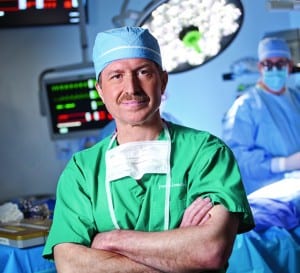
Mount Sinai’s chief of cardiac surgery
Last year, just weeks before the start of the NBA finals, Robert Hundevadt developed a lingering cold. The timing is significant for Hundevadt, director of security for the Miami Heat Group, because he was on the road. “Once in a while, I’ll do some work for the NBA and that weekend, I had to go to New Orleans for the All Star Game,” he said. “I had been treating the cold with over-thecounter drugs, but when I returned home, I still hadn’t improved.”
Tests revealed that Hundevadt was experiencing atrial fibrillation (A-Fib), the most common form of arrhythmia. Hundevadt’s A-fib was a byproduct of his heart working overtime due to mitral valve regurgitation, which occurs when the mitral valve doesn’t close completely and allows blood to leak backward toward the lungs. As a result, Hundevadt’s blood wasn’t moving through the rest of his body efficiently, making him tired and out of breath. This, along with the stress of the irregular heartbeat, was also weakening his heart muscle, causing it to grow. Hundevadt was on the verge of developing cardiomyopathy, a deadly form of heart disease in which the heart grows large, rigid and ultimately becomes unable to pump blood through the body.
After a review of Hundevadt’s condition, Dr. Joseph Lamelas, Mount Sinai’s chief of cardiac surgery, determined that a minimally invasive procedure known as the “ring and sling” would be the best treatment option.
“The ring and the sling are utilized in patients with weak and enlarged hearts along with a leaking mitral valve. Historically, we would repair the valve by only implanting a mitral repair ring, which brings the valves together and closes the leak, but that only addresses the valve – it doesn’t address the weakened heart muscle,” Dr. Lamelas explained.
“The sling is placed within the heart. It’s like placing a belt around the muscles within the heart that are responsible for maintaining its normal shape. This twofold approach attempts to restore or help recover as much heart muscle and valve function as possible.”
Dr. Lamelas is the only cardiac surgeon in the nation performing this procedure utilizing a minimally invasive technique.
“Because it’s a minimally invasive procedure, the heart remains in its normal location and there is less inflammation and trauma,” he explains. “Patients recover faster with this approach, as opposed to opening the chest through the breastbone.” Instead of making a 10- to 12-inch incision in the chest to fully expose the heart, Dr. Lamelas makes a twoinch incision between the ribs on the right side of the chest. Using specially designed minimally invasive instruments, some of which he designed, Dr. Lamelas is able to separate the ribs without cutting them and gain access to the heart to put the ring and sling in place.
Hundevadt’s procedure took place on Monday, May 23, and he was out of the hospital by the end of the week. “That Friday at 4 p.m., I was on the curb waiting for my wife to pick me up and drive me home,” he recalls. Aweek later, he was on light duty overseeing security for the Heat. Two weeks after surgery, he was embarking on a 12-day European cruise with his wife.
Since 2011, Dr. Lamelas has performed 48 ring and sling procedures, and 46 have resulted in improved heart function and size. He estimates that it takes six months to a year to see an improvement in the heart muscle. In the months since his procedure, Hundevadt says his strength and stamina have increased and he’s very pleased with his overall progress.
For information about Dr. Joseph Lamelas or the “Ring & Sling” procedure, call 305- 674-CARE (2273) or visit msmc.com.






